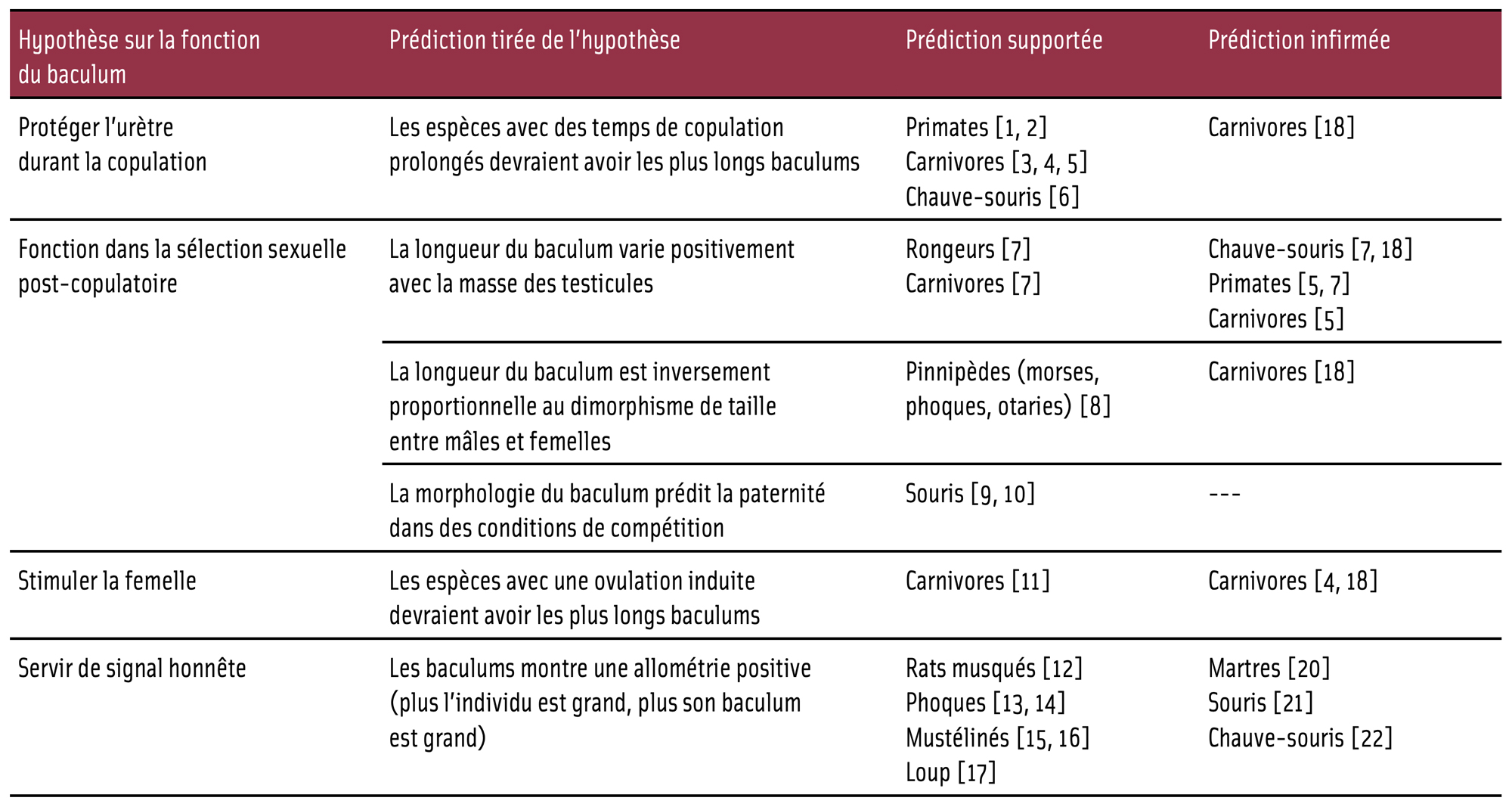Le baculum (annexe et bibliographie)
• 2023/numéro 48
Supplément à l'article “Le baculum : il y a un os…” de Bastien Beaujeu, étudiant en licence 2 “biologie des organismes, écologie, éthologie, évolution”, à l’université de Rennes 1
Pour résumer la littérature sur le sujet du baculum et de sa fonction chez les mammifères, tel qu’abordé dans mon article, voilà un tableau tiré de l’étude phylogénétique de N. G. Schultz et collègue de 2016 (voir référence complète dans la légende) agrémenté de quelques articles supplémentaires par votre fidèle serviteur. Les numéros des références intégrées entre crochets sont listés ci-dessous.

Tableau repris et adapté de Schultz N. G. et al., 2016 – “The baculum was gained and lost multiple times during mammalian evolution”, Integrative and Comparative Biology, 56(4), p. 644-656 (Doi : 10.1093/icb/icw034).
[1] Dixson A. F. et al., 1987 – “Baculum length and copulatory behavior in primates”, American Journal of Primatology, 13(1), p. 51-60 (Doi : 10.1002/ajp.1350130107).
[2] Dixson A. F. et al., 1987 – “Observations on the evolution of the genitalia and copulatory behaviour in male primates”, Journal of Zoology, 213(3), p. 423-443 (Doi : 10.1111/j.1469-7998.1987.tb03718.x).
[3] Brassey C. A. et al., 2018 – “Testing hypotheses for the function of the carnivoran baculum using finite-element analysis”, Proceedings of the Royal Society B: Biological Sciences, 285(1887), article n° 20181473 (Doi : 10.1098/rspb.2018.1473).
[4] Dixson A. F. et al., 1995 – “Baculum length and copulatory behaviour in carnivores and pinnipeds (Grand Order Ferae)”, Journal of Zoology, 235(1), p. 67-76 (Doi : 10.1111/j.1469-7998.1995.tb05128.x).
[5] Brindle M. et Opie C., 2016 – “Postcopulatory sexual selection influences baculum evolution in primates and carnivores”, Proceedings of the Royal Society B: Biological Sciences, 283(1844), article n° 20161736 (Doi : 10.1098/rspb.2016.1736).
[6] Herdina A. N. et al., 2015 – “Testing hypotheses of bat baculum function with 3D models derived from microCT”, Journal of Anatomy, 226(3), p. 229-235 (Doi : 10.1111/joa.12274).
[7] Ramm S. A., 2007 – “Sexual selection and genital evolution in mammals : a phylogenetic analysis of baculum length”, The American Naturalist, 169(3), p. 360-369 (Doi : 10.1086/510688).
[8] Fitzpatrick J. L. et al., 2012 – “Male contest competition and the coevolution of weaponry and testes in pinnipeds”, Evolution: International Journal of Organic Evolution, 66(11), p. 3595-3604 (Doi : 10.1111/j.1558-5646.2012.01713.x).
[9] Stockley P. et al., 2013 – “Baculum morphology predicts reproductive success of male house mice under sexual selection”, BMC Biology, 11(1), p. 1-6 (Doi : 10.1186/1741-7007-11-66).
[10] Winkler L. et al., 2021 – “The baculum affects paternity success of first but not second males in house mouse sperm competition”, BMC Ecology and Evolution, 21(1), p. 1-12 (Doi : 10.1186/s12862-021-01887-6).
[11] Brassey C. A. et al., 2020 – “Postcopulatory sexual selection and the evolution of shape complexity in the carnivoran baculum”, Proceedings of the Royal Society B, 287(1936), 20201883 (Doi : 10.1098/rspb.2020.1883).
[12] Tasikas D. E. et al., 2009 – “Baculum variation and allometry in the muskrat (Ondatra zibethicus) : a case for sexual selection”, Evolutionary Ecology, 23(2), p. 223-232 (Doi : 10.1007/s10682-007-9216-2).
[13] Miller E. H. et Burton L. E., 2001 – “It’s all relative : allometry and variation in the baculum (os penis) of the harp seal, Pagophilus groenlandicus (Carnivora : Phocidae)”, Biological Journal of the Linnean Society, 72(3), p. 345-355 (Doi : 10.1111/j.1095-8312.2001.tb01322.x).
[14] Miller, E. H. et al., 1999 – “Baculum and testes of the hooded seal (Cystophora cristata) : growth and size-scaling and their relationships to sexual selection”, Canadian Journal of zoology, 77(3), p. 470-479 (Doi : 10.1139/z98-233).
[15] Krawczyk, A. J. et al., 2011 – “Is baculum size dependent on the condition of males in the polecat Mustela putorius ?”, Folia Zoologica, 60, p. 247–253 (Doi : 10.25225/fozo.v60.i3.a9.2011).
[16] Čanády A. et Onderková A., 2016 – “Are size, variability and allometry of the baculum in relation to body length signals of a good condition in male weasels Mustela nivalis ?”, Zoologischer Anzeiger-A Journal of Comparative Zoology, 264, p. 29-33 (Doi : 10.1016/j.jcz.2016.07.003).
[17] Čanády A. et Čomor Ľ. 2015 – “Allometry of the baculum in the wolf (Canis lupus, Canidae) as an indicator of viability and quality in males”, Zoology and Ecology, 25(3), p. 192-198 (Doi : 10.1080/21658005.2015.1044164).
[18] Larivière S. et Ferguson S. H., 2002 – “On the evolution of the mammalian baculum : vaginal friction, prolonged intromission or induced ovulation ?”, Mammal Review, 32(4), p. 283-294 (Doi : 10.1046/j.1365-2907.2002.00112.x).
[19] Hosken D. et al., 2001 – “Is the bat os penis sexually selected ?”, Behavioral Ecology and Sociobiology, 50, p. 450-460 (Doi : 10.1007/s002650100389).
[20] Schulte-Hostedde A. I. et al., 2011 – “Allometry of the baculum and sexual size dimorphism in American martens and fishers (Mammalia : Mustelidae)”, Biological Journal of the Linnean Society, 104(4), p. 955-963 (Doi : 10.1111/j.1095-8312.2011.01775.x).
[21] Ramm S. A. et al., 2010 – “Sexual selection and the rodent baculum : an intraspecific study in the house mouse (Mus musculus domesticus)”, Genetica, 138, p. 129-137 (Doi : 10.1007/s10709-009-9385-8).
[22] Lüpold S. et al., 2004 – “Bat genitalia : allometry, variation and good genes”, Biological Journal of the Linnean Society, 83(4), p. 497-507 (Doi : 10.1111/j.1095-8312.2004.00407.x).
